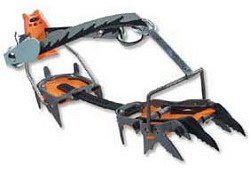
 Exploration
Exploration
Going to the Ends of the Earth
By "Exploration" we mean discoveries made while traveling from place to place, as opposed to research undertaken in one fixed geographical location (such as Barrow, AK, or McMurdo Station or the South Pole.) Exploration adds logistical challenges (bad weather, broken equipment, slow progress in crevassed territory) to all the usual risks of scientific research - hunches and hypotheses that don't pan out, experimental protocols that just don't work. What makes polar research so engaging, however, is just this: it's a physical as well as intellectual adventure. Not all of the folks you'll read about here are classic "A" students: some of them are mechanics, others specialize in science support (including cooking - not a trivial skill out on The Ice) but all of their diverse talents are needed to make these small teams safe and successful. Most of the explorers, in fact, end up doing a little bit of everything, with Principal Investigators erecting tents and cleaning up along with all the others. We'll be adding more and more expeditions as IPY "heats up."
 |
Polar Discovery: Woods Hole Oceanographic Institution Researchers from the Woods Hole Oceanographic Institution (WHOI) will deploy instruments that will make year-round observations of the water beneath the Arctic ice cap to learn more about the changing global climate. |
 |
Ann Bancroft and Liv Arnesen Explore the Arctic Ocean Tune in during March 2007 for the latest in a series of dynamic adventures from a dynamic duo of female explorers. |
 |
Deep Ocean Expeditions An expedition to, and down below, the North Pole! The final great exploration at the North Pole will be a submersible expedition to the real North Pole, 14,400 feet deep below the ice. |
 |
US ITASE: The US component of a multi-year attempt to reach out beyond field stations to capture snow and ice data through long traverses. The 2006-2007 US ITASE team was in Antarctica from November 3 through January 22th. |
 |
ANSMET: The Antarctic Search for Meteorites, as seen in one of our premiere podcasts.This NSF-, NASA- and Smithsonian project has discovered chunks of the Moon, Mars and asteroid belt out on the smooth "blue ice" of remote field locations. Check out our podcast for scenes from 2006-2007,and then read more online. |
 |
Matthew Sturm's Barrenlands traverse: Sturm, at UA Fairbanks, AK, has made many scientifically-productive traverses across the state, sampling the snow he seems to have an uncanny knowledge of and love for. His expedition starts around March 15, 2007, but his intriguing website's already in place. |
 |
CReSIS: The Center for Remote Sensing of Ice Sheets (CReSIS) is a Science and Technology Center established by the National Science Foundation (NSF) in 2005, with the mission of developing new technologies and computer models to measure and predict the response sea level change to the mass balance of ice sheets in Greenland and Antarctica. |
 |
Global Warming: The Online NewsHour Global Warming Debate. |
 |
Global Warming: Lesson plans written for grades 6-12 on global warming. |
 |
Dr. Eric Hiatt - Antarctic Research: Dr. Eric Hiatt is part of a team of geologists headed by Dr. Kathy Licht of Indiana University (IUPUI, and a PPZA Presenter in Albuquerque and San Francisco), Dr. Lang Farmer of the University of Colorado, Dr. John Goodge, of the University of Minnesota-Duluth, Mountaineer Peter Braddock, Dr. Jeff Swope of IUPUI, and graduate students Kate Kramer and Emerson Palmer both of IUPUI, and Devon Brecke at University of Minnesota-Duluth. Our research seeks to delineate the sources of sediment being transported into the Ross Sea. Our work will add to knowledge about the bedrock geology under the East Antarctic Ice Sheet, which currently is poorly understood. We also are trying to determine the relative roles glaciers from the East Antarctic sheet play, vs. those of the West Antarctic Ice sheet, in building the Ross Ice Shelf; this will provide constraints on glacial flow path computer models. Understanding the Ross Ice Shelf is important because with current rates of sea level rise and global climate change, it has the potential to collapse and release large amounts of fresh water to the surface oceans. |
|



